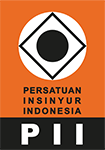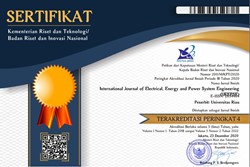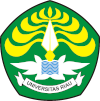Analysis of LTE Network Quality of Service on Streaming Application
Abstract
QoS (Quality of Service) measurement of LTE (Long Term Evolution) networks is carried out using the Telkomsel provider. Measurements were made in Perawang, Riau at night. QoS measurements are carried out at Perawang to evaluate and monitor network quality in accessing vidio streaming services provided by the Telkomsel network in the Perawang, Riau. Measurements were aimed at 5 streaming applications, namely YouTube, RCTI+, Online Radio, Twitch, and Vidio. The reason 5 applications are used for QoS measurement is that these applications are popular applications used in the category of Vidio streaming applications. Measurements were carried out for 160 seconds. The measurement results will be analyzed for quality based on the TIPHON standard. The results were obtained by calculating the data that has been obtained by Wireshark. The data will be calculated using the existing equations. Twitch is the only application that has a value of four in the QoS parameter index category and has a QoS value with an excellent index category. 4 other applications have a QoS value with a good index category. This is due to the low value of the throughput index category. Online Radio and Vidio applications have an index category value of 0. YouTube and RCTI+ applications have a throughput index category value of 1 and 2 respectively. For jitter, packet loss, and delay values, 5 streaming applications have an excellent index category with a value of 4. The measurement results that have been obtained would be displayed in the form of tables and graphs.
References
S. Suroso, C. Ciksadan, and S. Sholihatun, “Analisis Quality of Service Video Streaming Youtube Dan Rma Wlan Di Politeknik Negeri Sriwijaya,” TESLA: Jurnal Teknik Elektro, vol. 22, no. 2, p. 93, 2020.
B. Hardiyanto, “Analisis Quality of Service (QoS) Jaringan 4G LTE Melalui Drive Test di BBPLK Bekasi Menggunakan Aplikasi Netmonitor Cell Signal Logging,” Jurnal Engineering Edu, vol. 6, no. 2, pp. 1–8, 2020.
A. J. S and B. Gozali, “Perbaikan Performansi Video Call Menggunakan Jaringan LTE,” Sainstech: Jurnal Penelitian dan Pengkajian Sains dan Teknologi, vol. 26, no. 1, pp. 80–86, 2018.
. A. M. Miyim and A. Wakili, “Performance Evaluation of LTE Networks,” 2019 15th International Conference on Electronics, Computer and Computation, ICECCO 2019, no. Icecco, pp. 1–6, 2019.
H. Fahmi, “Analisis Qos (Quality of Service) Pengukuran Delay, Jitter, Packet Lost Dan Throughput Untuk Mendapatkan Kualitas Kerja Radio Streaming Yang Baik,” Jurnal Teknologi Informasi dan Komunikasi, vol. 7, no. 2, pp. 98–105, 2018.
Mitra Unik, S. Soni, and Randra Aguslan Pratama, “Penerapan Metode Htb Dan Diffserv Guna Peningkatan Qos Pada Layanan Video Streaming,” Jurnal Fasilkom, vol. 9, no. 3, pp. 35–40, 2019.
. A. H. Wafie and E. P. Laksana, “Quality of Service (QoS) Jaringan 4G LTE Pada Layanan Video Conference Studi Kasus Di Perpustakaan Univeristas Budi Luhur,” Jurnal Maestro, vol. 1, no. 2, pp. 365–376, 2018.
A. R. Rahmatika, S. Sukiswo, and E. D. Widianto, “Quality of Service Analysis of Long-Term Evolution Network in Frequency Division Duplexing Mode in Semarang City,” Teknik, vol. 41, no. 1, pp. 62–71, 2020.
P. R. Utami, “Analisis Perbandingan Quality of Service Jaringan Internet Berbasis Wireless Pada Layanan Internet Service Provider (Isp) Indihome Dan First Media,” Jurnal Ilmiah Teknologi dan Rekayasa, vol. 25, no. 2, pp. 125–137, 2020.
A. Charisma, A. D. Setiawan, G. M. Rahmatullah, and M. R. Hidayat, “Quality f Service (QoS) n 4G Telkomsel Networks in Soreang,” pp. 145–148.
S. Sirmayanti, A. Tain, and N. K. Hamzidah, “Comparative Study of QoS on Video Meeting Tool Application in 4G LTE Network using Wireshark,” SISTEMASI, vol. 12, no. 1, p. 31, Jan. 2023.
P. R. Utami, “Analisis Perbandingan Quality of Service Jaringan Internet Berbasis Wireless Pada Layanan Internet Service Provider (ISP) Indihome Dan First Media,” Jurnal Ilmiah Teknologi dan Rekayasa, vol. 25, no. 2, pp. 125–137, Aug. 2020.
N. L. Marpaung, R. D. Saputri, and R. Amri, “Quality of Service from a Network when Using Youtube Application”, IJEEPSE, vol. 5, no. 1, pp. 12-18, Feb. 2022.
A. R. Maulana, H. Walidainy, M. Irhamsyah, F. Fathurrahman, and A. Bintang, “Analisis Quality of Service (QoS) Jaringan Internet Pada Website E-Learning Univiersitas Syiah Kuala Berbasis Wireshark,” Jurnal Komputer, Informasi Teknologi, dan Elektro, vol. 6, no. 2, Oct. 2021.
H. Lan, J. Xu, Q. Wang, and W. Ding, “Packet Loss Measurement Based on Sampled Flow,” Symmetry (Basel), vol. 13, no. 11, p. 2149, Nov. 2021.
B. F, R. C, R. A, R. M, S. F, and S. G, “An Advanced QOS Analysis and Evaluation Method for Mobile Internet Access,” International Journal of Wireless & Mobile Networks, vol. 8, no. 3, pp. 55–70, Jun. 2016.
Copyright (c) 2023 RA Rizka Qori Yuliani Putri, Anhar Anhar, Aguinaldo Al Nazen, Aris Setiawan, Dede Abdul Kholik

This work is licensed under a Creative Commons Attribution-NonCommercial 4.0 International License.


















